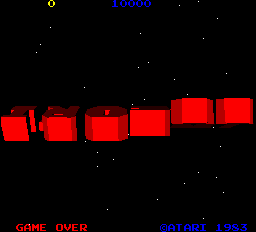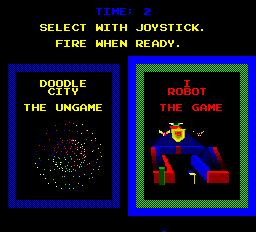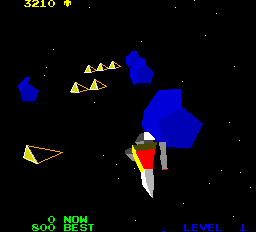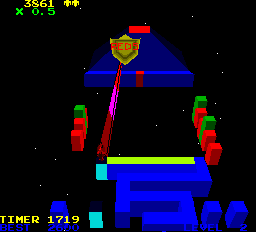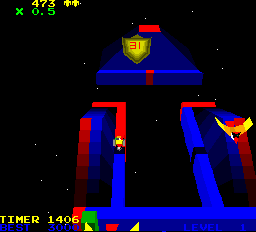 The Game: A huge, Big Brother-like head pops up and says “The law: no jumping!” to your little robot, and naturally, the cocky little automaton has other ideas (replying “Oh yeah!”). And so your mission begins, guiding the robot over ramps, around narrow catwalks, and leaping across huge chasms. If the all-seeing eye opens while your robot it jumping, however, a blaster turns your hero into a heap of spare parts. If you successfully claim all of the red area on the screen, you have a narrow “launch window” in which to jump across to the eye’s platform and destroy it. The your robot launches into space, blowing away obstacles in his path, avoiding saucers and solid objects, and eventually landing on another series of ramps and catwalks to begin the quest anew. And if that doesn’t do it for you, you can put in another quarter and relax in Doodle City. (Atari, 1983)
The Game: A huge, Big Brother-like head pops up and says “The law: no jumping!” to your little robot, and naturally, the cocky little automaton has other ideas (replying “Oh yeah!”). And so your mission begins, guiding the robot over ramps, around narrow catwalks, and leaping across huge chasms. If the all-seeing eye opens while your robot it jumping, however, a blaster turns your hero into a heap of spare parts. If you successfully claim all of the red area on the screen, you have a narrow “launch window” in which to jump across to the eye’s platform and destroy it. The your robot launches into space, blowing away obstacles in his path, avoiding saucers and solid objects, and eventually landing on another series of ramps and catwalks to begin the quest anew. And if that doesn’t do it for you, you can put in another quarter and relax in Doodle City. (Atari, 1983)
Memories: Once arcade games caught on as the profitable concern of the 80s, it seemed like everyone who had even the tip of a single finger in the electronics or coin-operated business glutted the market with barely-disguised riffs on the Pac-Man or Defender or Space Invaders concepts, saturating a previously innovative market with cheap copycat games (or, in a few cases until the attorneys caught up with them, outright bootlegs). In many ways, this parallels the Atari-era crash of the home video game cartridge industry, and it’s hardly a coincidence that both industries suffered simultaneous catastrophic shakedowns.
 The real innovation became harder to find, and such is the tragic fate of I, Robot, programmed by Dave Theurer, the Atari coin-op mastermind who gave the world Tempest and Missile Command. In some ways, I, Robot echoes elements of other games, including Make Trax and Q*Bert (claiming territory on the screeen by turning it a certain color) and any number of early first-person space combat sims. Where it differs is its look and execution: to survive any length of time in this game, you must be prepared to stop moving, and wait for the threat of the all-seeing eye to pass.
The real innovation became harder to find, and such is the tragic fate of I, Robot, programmed by Dave Theurer, the Atari coin-op mastermind who gave the world Tempest and Missile Command. In some ways, I, Robot echoes elements of other games, including Make Trax and Q*Bert (claiming territory on the screeen by turning it a certain color) and any number of early first-person space combat sims. Where it differs is its look and execution: to survive any length of time in this game, you must be prepared to stop moving, and wait for the threat of the all-seeing eye to pass.
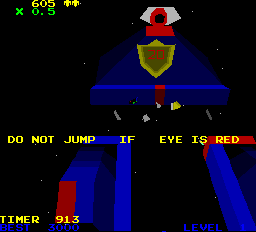 And as for its look? I, Robot is one of the first arcade games to use polygon-based graphics to create 3-D objects, as opposed to simpler, scalable two-dimensional shapes. In some ways, I, Robot also introduces the “floating camera,” a viewpoint which zooms in or out according to the player’s position and the arrival of various threats to his robot. It can be a little disconcerting, but it’s tame compared to the swinging, airborne-Steadicam perspectives that are the bane of many modern-day console gamers’ existence. Here, at least, it was something new and different, adding to the challenge, not just the flavor of the day getting in the way of yet another game.
And as for its look? I, Robot is one of the first arcade games to use polygon-based graphics to create 3-D objects, as opposed to simpler, scalable two-dimensional shapes. In some ways, I, Robot also introduces the “floating camera,” a viewpoint which zooms in or out according to the player’s position and the arrival of various threats to his robot. It can be a little disconcerting, but it’s tame compared to the swinging, airborne-Steadicam perspectives that are the bane of many modern-day console gamers’ existence. Here, at least, it was something new and different, adding to the challenge, not just the flavor of the day getting in the way of yet another game.
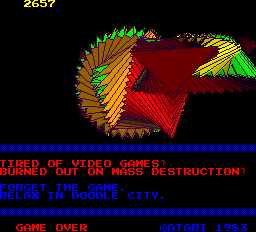 Adding to the non-hurried feel of the game play was Doodle City, quite possibly the first-ever coin-op creativity application, allowing players to forgo dodging laser beams and jumping across infinite chasms for the simpler charm of drawing with the game’s polygonal graphics engine. Once you finished doodling in Doodle City, you’d have to insert another quarter if you wanted to play a regular round of I, Robot, but sometimes the sheer chill-out factor was worth it.
Adding to the non-hurried feel of the game play was Doodle City, quite possibly the first-ever coin-op creativity application, allowing players to forgo dodging laser beams and jumping across infinite chasms for the simpler charm of drawing with the game’s polygonal graphics engine. Once you finished doodling in Doodle City, you’d have to insert another quarter if you wanted to play a regular round of I, Robot, but sometimes the sheer chill-out factor was worth it.
Sadly, I, Robot never caught on, failing to be brought home to any of the Atari consoles, and even modern-day retro collections on higher-powered platforms have eschewed it in favor of  other Atari coin-ops. One infamous April Fools’ Day prank in 2002 saw AtariAge.com’s claim – complete with authentic box and cartridge art – to have found an uncompleted I, Robot prototype for, of all systems, the Atari 2600. Even 20 years later, I, Robot has never made that U-turn into respectability outside of the ranks of video game historians and collectors.
other Atari coin-ops. One infamous April Fools’ Day prank in 2002 saw AtariAge.com’s claim – complete with authentic box and cartridge art – to have found an uncompleted I, Robot prototype for, of all systems, the Atari 2600. Even 20 years later, I, Robot has never made that U-turn into respectability outside of the ranks of video game historians and collectors.
